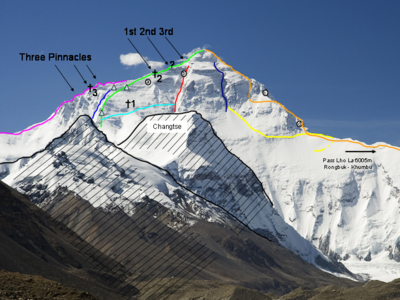
Three Steps
Encyclopedia
The Three Steps are three prominent rocky steps to the northeast of Mount Everest
. They are located at altitudes of , , and . The Second Step is especially significant both historically and in mountaineering terms. Any climber who wants to climb on the normal route from the north of the summit must negotiate these three stages.
 The First Step consists of large boulders that pose a serious obstacle for experienced climbers because of their height above sea level.
The First Step consists of large boulders that pose a serious obstacle for experienced climbers because of their height above sea level.
The Second Step is the best known of the rocky steps. The steep section, at an altitude of , has a climbing height of forty metres, of which the last five are almost vertical. The step was climbed for the first time in 1960 by Wang Fu-chou, Konbu, and Chu Ying-hua. The climbing difficulty of this spot was reduced in 1975 when a Chinese team affixed a ladder to the step that has been used since then by almost all climbers.
The Third Step is easier to climb. Its climbing height is about 10 metres, after which the summit snowfield is reached.
was the first to attempt to climb of Mount Everest. They had to make the ascent from the north. The technical difficulties, especially in climbing the Second Step, were still unknown; the step was probably never reached by these expeditions. It was first achieved in 1960 as part of the first ascent of Mount Everest via the north route. Here, a shoulder stand was used to climb the last five metres.
The step was first climbed unaided in 1985 by the Catalan, Oscar Cadiach. He assessed the final rock face as 5.7 to 5.8
(V+ in UIAA classification).
The Austrian, Theo Fritsche, climbed the step in 2001 free solo on-sight and came to a similar conclusion. Conrad Anker
climbed the Second Step in 1999 and assessed the level of difficulty as 5.10. On this ascent Anker supported himself using the Chinese ladder. In 2007, Anker repeated the climb with Leo Houlding; this time, however, he first removed the ladder in order to climb the step unaided
.
Mount Everest
Mount Everest is the world's highest mountain, with a peak at above sea level. It is located in the Mahalangur section of the Himalayas. The international boundary runs across the precise summit point...
. They are located at altitudes of , , and . The Second Step is especially significant both historically and in mountaineering terms. Any climber who wants to climb on the normal route from the north of the summit must negotiate these three stages.

The Second Step is the best known of the rocky steps. The steep section, at an altitude of , has a climbing height of forty metres, of which the last five are almost vertical. The step was climbed for the first time in 1960 by Wang Fu-chou, Konbu, and Chu Ying-hua. The climbing difficulty of this spot was reduced in 1975 when a Chinese team affixed a ladder to the step that has been used since then by almost all climbers.
The Third Step is easier to climb. Its climbing height is about 10 metres, after which the summit snowfield is reached.
Important climbs of the Second Step
The British Mount Everest Expedition before World War IIWorld War II
World War II, or the Second World War , was a global conflict lasting from 1939 to 1945, involving most of the world's nations—including all of the great powers—eventually forming two opposing military alliances: the Allies and the Axis...
was the first to attempt to climb of Mount Everest. They had to make the ascent from the north. The technical difficulties, especially in climbing the Second Step, were still unknown; the step was probably never reached by these expeditions. It was first achieved in 1960 as part of the first ascent of Mount Everest via the north route. Here, a shoulder stand was used to climb the last five metres.
The step was first climbed unaided in 1985 by the Catalan, Oscar Cadiach. He assessed the final rock face as 5.7 to 5.8
Grade (climbing)
In rock climbing, mountaineering and other climbing disciplines, climbers give a climbing grade to a route that concisely describes the difficulty and danger of climbing the route...
(V+ in UIAA classification).
The Austrian, Theo Fritsche, climbed the step in 2001 free solo on-sight and came to a similar conclusion. Conrad Anker
Conrad Anker
Conrad Anker is an American rock climber, mountaineer, and author famous for his challenging ascents in the high Himalaya and Antarctica. He is a member of The North Face climbing team and also works closely with Timex Expedition as brand ambassador...
climbed the Second Step in 1999 and assessed the level of difficulty as 5.10. On this ascent Anker supported himself using the Chinese ladder. In 2007, Anker repeated the climb with Leo Houlding; this time, however, he first removed the ladder in order to climb the step unaided
Free climbing
Free climbing is a type of rock climbing in which the climber uses only hands, feet and other parts of the body to ascend, employing ropes and forms of climbing protection to prevent falls only....
.
Sources
- Mantovani, Roberto and Diemberger, Kurt (1997). Mount Everest – Kampf in eisigen Höhen. Moewig. ISBN 3-8118-1715-9
- Hemmleb, Jochen (2009). Tatort Mount Everest: Der Fall Mallory – Neue Fakten und Hintergründe. Herbig, Munich. ISBN 978-3-7243-1022-8.

